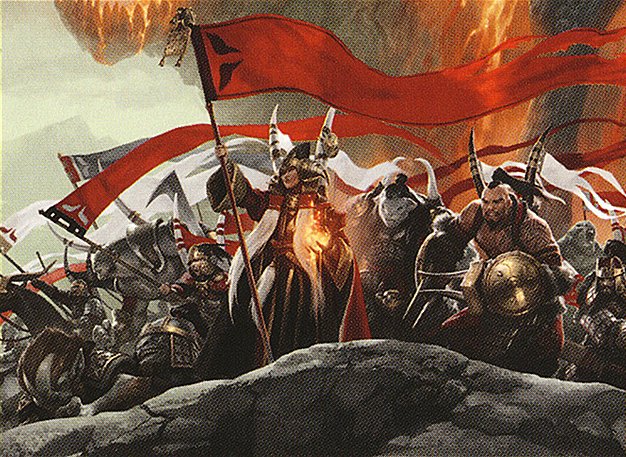 Art by Jason Chan
Art by Jason ChanA low power, budget cube designed with the five enemy three colour pairings, or 'wedges,' in mind. These five colour pairings have the following primary and secondary archetypes:


 - Jeskai
- Jeskai
- Artifact Aggro
- Control


 - Mardu
- Mardu
- Sacrifice Aggro
- Aristocrats


 - Abzan
- Abzan
- Midrange
- Lifegain


 - Sultai
- Sultai
- Control
- Reanimator


 - Temur
- Temur
- Tempo
- Stompy
In addition to these core archetypes, there are a small number of additional archetypes that are also supported, although more limitedly than the primary archetypes:




 - WUBRG Morphs
- WUBRG Morphs
Putting the morph creatures that are often neglected to good use.

 - Rakdos Combo
- Rakdos Combo
Using Putrid Goblin, Sling-Gang Lieutenant and First Day of Class/Thran Vigil to go infinite. Consider splashing blue for counters.
Additional Cube Rules:
To make morph cards more relevant to the draft, the following cards have been errata'd to increase their playability.
Efreet Weaponmaster
Ponyback Brigade
Abzan Guide
Abomination of Gudul
Snowhorn Rider
Each of these cards has been errata'd so that their morph cost costs  less to activate, making it only cost the khan's three colors of mana to flip face up.
less to activate, making it only cost the khan's three colors of mana to flip face up.
This change is intended to allow the cube to emulate aspects of the khans of tarkir limited environment's engaging combat created by the heavy presence of morph creatures. Even if not widely played, the morph creatures in the cube are intended to add to the mystery of the face down creatures.
Hey there!
Today I wanted to talk about my cube's manabase and what design choices I made when I constructed it. I hope that I can get you thinking about your own manabase and what types of lands you want to run.
My cube is a three color wedge cube, so that has a great deal of an effect on the manabase. The manabase has to have enough fixing and support to allow these three color decks that are supposed to make up most of the format to play smoothly and not get very screwed on mana. I also have to push the drafters subtly towards the five three color pairings I want, which I accomplish in a couple of ways. Central to accomplishing all of this is my package of fetches and tutorable tap lands.
First of all, the fetches. I run two sets of the Tarkir's five ally fetches, both for flavor and for function. Fetchlands are unbelievably strong in constructed formats, but since we determine the card pool, we can adjust how powerful these fetches are by what targets we provide them with. With only basic lands as targets, the fetches act similar to pathways, with a couple of caveats that don't matter as far as color fixing goes. This would make the fetches extremely underpowered, like what we see in tarkir limited. They're still a fixing land, yes, but far from the power of a fetch shock. The inclusion of these powerful shocklands in with the fetches is something many have talked about before. It makes fetches able to search for any color of mana as long as you have the right lands and the ability for them to be able to enter untapped means you don't take a large tempo hit when you take advantage of the lands. I think this is too strong for my format, which aims to have a power level closer to standard than modern or even vintage. My solution is to run the tap lands from dominaria united, which each have two basic land types. This allows drafters to utilize the sheer fixing power of the fetches at a tempo drawback, or they have the option of fetching basic lands if they need to play something straight away. The lands add even more minute decisions to the gameplay and the draft, which I enjoy.
Second, the three color archetypes. I have a few ways of narrowing down the sheer fixing power of the fetches into nudging players towards the wedges. I have two main ways of accomplishing this as far as the manabase is concerned. I run two sets of the Tarkir uncommon tri-taplands, which are powerful for the wedge each belongs too, but aren't useless to its neighbors either. For example, if no one at the table is drafting Sultai, an Opulent Palace is still useful to an Abzan deck, acting like a Foul Orchard. This allows the lands to provide strong fixing to specific archetypes without wheeling over and over. In addition to these lands, the count of the dominaria united lands has a great effect on the manabases of decks. I run one full cycle of these lands, but an additional set of the enemy lands. This means a player is disincentivized to start drafting Selesnya early, which can only become Abzan, but incentivized to draft golgari, which can pivot into Sultai or Abzan, depending on which is more open. This makes staying open and comfortably easing into one of the wedges much easier. Finally, the allied color fetches. The reason I run allied fetches and not enemy fetches like how I run more enemy taplands than allied taplands is that the allied fetches can actually be used by any of the five wedges as long as they get the right taplands, which are already scewed towards playing enemy color pairings. By this I mean that a flooded strand is usable by a Mardu deck because it can search up a basic plains, a sacred peaks or a sunlit marsh, giving access to all three of its colors. It is also fully playable in Sultai, since it can fetch a basic Island, a Contaminated Aquifer or a Tangled Islet. Notably, it's mostly useless in Jund, since it would only search for taplands that are half on color. Likewise, an arid mesa is useless for Sultai. This is bad considering fetchlands are good enough that it feels bad to pass one. This all ultimately means that if you draft a fetchland early, you've got access to powerful fixing in any color and leaving you open to any strategy as long as you pick up the right taplands later on, forcing you to choose your priorities carefully.
So all of this to say that my combination of fetchlands, typed taplands in more enemy colors than allied and tri-lands aims to force players to make more decisions and subtly nudging them towards the three color archetypes.
Hopefully I've got you thinking about the effects of manabases on how their cubes run.
Thanks for chatting cube with me!
-Gruz
